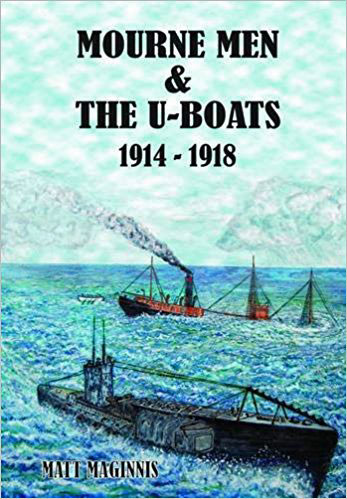 Bangor Historical Society met on the 8 February to hear a talk by Matt Maginnis on the Mourne Men and the U-Boats 1914-18. At the start of the meeting the chairman, Ian Wilson paid tribute to Eddie Beckett who had died aged 90. He was a founder member of Bangor Historical Society and had contributed an article to the Society’s Journal on the Anglo-Norman site which he had discovered in the garden of his home at Riverside.
Bangor Historical Society met on the 8 February to hear a talk by Matt Maginnis on the Mourne Men and the U-Boats 1914-18. At the start of the meeting the chairman, Ian Wilson paid tribute to Eddie Beckett who had died aged 90. He was a founder member of Bangor Historical Society and had contributed an article to the Society’s Journal on the Anglo-Norman site which he had discovered in the garden of his home at Riverside.
Mr Maginnis began his talk by explaining how he had become interested in the topic through family connections. He had conducted research in a number of archives including the Public Record Office at Kew. He then told us about a number of encounters between local vessels and U-Boats in the Irish Sea. By 1917 the Germans had resumed unrestricted submarine warfare so that any type of ship might be attacked. One story involved James Ferguson, a schooner captain from Kilkeel and Otto Steinbrinck, captain of UC65. On the night of 2 May Ferguson’s boat, the Earnest, was heading from Ardrossan to Dublin with a cargo of coal. The U-Boat had already attacked four ships in the Ballyhalbert area. At first the crew of the Earnest thought it was a sailing vessel. Warning shots were fired from the submarine and the schooner crew was given five minutes to take to a small boat. Charges were then put on board and the schooner was sunk. The Earnest’s crew were picked up by a patrol boat. Captain Ferguson gave Naval Intelligence a full account of what happened.
A sinking from 1915 involved Mr Maginnis’ grandfather and great uncle on the SS Kilcoan. The U21 under the command of Otto Hersing was sent through the Straits of Dover to widen the war into the Irish Sea. After attacking other vessels it encountered the Kilcoan on 30 January 1915 which was carrying coal from the Mersey to Belfast. The crew was ordered off the steamer. Captain Meneely was taken back on board to collect the ship’s papers. The Kilcoan’s crew refused the offer of cigars and cigarettes while they were on the deck of the submarine. A scuffle followed. The submarine left after sinking the Kilcoan, but it commandeered another vessel, the Gladys to go back and rescue the Kilcoan’s crew, now on the lifeboats. They were taken to the Isle of Man. Hersing became a folk hero in Germany because of his exploits.
Another interesting story had direct reference to Bangor. On 7 May 1915 the Lusitania was sunk off the south coast of Ireland by U20. The torpedo man on the submarine was Raymond Weisbach. He later commanded the U19 which landed Roger Casement on the west side of Ireland in 1916 where he was captured by the British. The submarine deck gun from the U19 now stands in Ward Park. It was donated in recognition of Barry Bingham’s contribution to the naval war which earned him a VC.
Dr Floyd was a very famous doctor in the Mourne area for 53 years. He was a close friend of the song writer Percy French. His son Hayden enlisted and became a dispatch rider at the trenches. In 1916 he was offered a commission in the Royal Flying Corps. In July 1916 he was acting as an observer when his plane was shot down over German lines. He died of his wounds as a prisoner in a German hospital. When his father Dr Floyd heard of his death he joined the Royal Medical Corps. He served at Gallipoli. He was on a hospital ship when it was torpedoed off the Isle of Wight. The Gloucester Castle had 400 casualties on board, 300 of whom were cot cases. The chief medical officer and Doctor Floyd followed the evacuation plans and did not lose a single casualty. Ladders, stretchers and even laundry baskets were employed to get people off the ship.
A very controversial incident took place in October 1918. The U90 sank the SS Dundalk when she was returning from Liverpool. Only 12 crew members survived. The submarine came to the surface, but would not help the men in the lifeboats. Then another steamer came along: the SS Carlingford. It slowed down when it saw the lifeboats, but then sailed on. It was 17 hours before the men from the SS Dundalk were rescued. When the SS Carlingford got to Dundalk it raised the alarm, but many in the town were horrified that it did not stop to rescue the crew in the lifeboats. The Captain was said to have run for his life from angry crowds. Yet he was following orders. Ships were not allowed to stop in case they in turn became a target for the submarines.
Ultimately the submarine threat was defeated by various measures including the use of the convoy system, mines and primitive hydrophones for detecting submarines under water. Mr Maginnis concluded his very interesting talk by showing us a picture of the memorial to the merchant seamen at the Nautilus Centre in Kilkeel.
